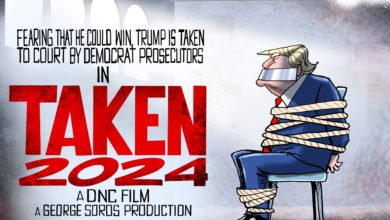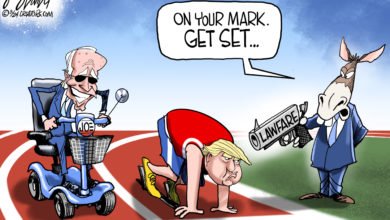Financial Crisis…a “Top Down, Bottom Up, Inside Out” Designed Collapse from Home Loans to Student Loans
As the fiscal cliff looms, it is prudent to discuss how we got here. As our crisis moves from housing to student loan and then into health care, it should be noted what, how and who got us into this situation.
“…because this financial crisis just wasn’t the result of decisions made in the executive suites on Wall Street, it was also the result decisions made across kitchen tables across America by folks who took on mortgages and credit cards and auto loans,”
Barrack Obama, Wall Street, April 22, 2010
During a 2010 speech at Wall Street, President Obama blamed Wall Street and Main Street for irresponsible financial practices but he neglected the true culprit of the housing crisis…the federal government. When third parties such as Washington politicians, bureaucrats and community organizations get involved, it perpetuated the housing disaster in what we have today.
So, how do you collapse the housing market? You start with the philosophy of “Overloading the system” with an approach known as “Top Down, Bottom Up and Inside Out. Van Jones explains this concept below. Politicians and bureaucrats wrote legislation that entice community organizations, citizens and lawyers to force banks in giving loans they should not have given. This concept begins with the passage of the Community Reinvestment Act, then relaxing HUD policies with unrealistic goals. The Clinton Administration and Congress put pressure on banks, this represents the “Top Down” portion. This placed the legal ability for banks to make risky “subprime” loans. The “Bottom Up” is community organizations, like ACORN and lawyers who push the written law through the court system. These community organizations put pressure or extorted banks through threats of lawsuits. With Fannie and Freddie’s loan goals increased, pressure from federal agencies and community groups demanding risky loans to be made, this is the “Top Down, Bottom Up” scenario. The “Inside Out” scenario is where people within the system begin to work with the community organizations or replaced with people who are friendly to organizations that caused the problems.
So, what caused the subprime lending crisis? Let’s start with the Community Reinvestment Act.
In 1977, the Community Reinvestment Act (CRA) established the foundation for the housing crisis and “encouraged” financial institutions to provide loans to low- and moderate-income communities. It eliminated “redlining”, a practice where banks identify and eliminate lending to certain high-risk communities. But one of the most damaging aspects of the act was the creation of a rating system that evaluated banks on several factors, one being their subprime loan record. The CRA addressed concerns of the deteriorating conditions of cities like urban flight and declining neighborhoods, this was due to limited credit availability. After the CRA was enacted, the federal government continued to tweak previsions for the next 30 years to provide loans to risky borrowers, loosen restrictions so banks were able to give these loans and provided legal grounds for community organizations and lawyers to force these loans.
After the passage of the CRA, trends of outstanding consumer credit skyrocketed. (See chart below)
The Glass-Steagall Act of 1933 kept banks in check. It limited the affiliation between commercial banks and security firms, this also eliminated financial transactions being granted within the same credit, lending and investing institutions, also known as “too big to fail.” What this would do is tie loans to the banks physical assets. Back in 1933, this act gave additional oversight authority to the Federal Reserve. In addition, the FDIC would be able to guarantee loans up to a certain amount.
Ben Bernanke explained that the CRA encouraged many banks to make high-risk loans to low and middle-income communities at low interest rates. The Financial Institution Reform, Recovery and Enforcement Act of 1989 (FIRREA) publicized these CRA reports public. This allowed community organizations and lawyers to “perform more-sophisticated, quantitative analyses of banks’ records.” If a bank’s ratings were not adequate, community organizations such as Association of Community Organizations for Reform Now (ACORN) sued banks for the lack of loans in low income communities.
In 1980, Jimmy Carter signed the HR 4986, “Depository Institutions Deregulation and Monetary Control Act” forcing banks to adhere to Federal Reserve rules. It allowed the merger of banks and raised deposit insurance from $40,000 to $100,000.
In 1992, the Housing and Community Development Act of 1992 “establish(ed) specified housing goals for each enterprise, including goals for purchase of mortgages on housing for low- and moderate-income families”. These two Government-Sponsored Enterprises (GSE), Fannie Mae and Freddie Mac, encouraged “subprime” lending by authorizing a “flexible” criteria whereas high-risk borrowers could be qualified for home loans. These GSEs were intermediaries who loan to banks and not directly to homeowners. Banks were directed to accept welfare payments and unemployment benefits as “valid income sources” in qualifying for mortgages. If banks didn’t accept these documents, they could face lawsuits.
In 1994, Housing and Urban Development (HUD) instituted a “top down” policy where ten federal agencies adopted a policy, entitled “Policy Statement on Discrimination in Lending”. According to the news release “The following Federal Agencies—HUD, OFHEO, DOJ, OCC, OTS, the Board, FDIC, FHFB, FTC and the NCUA—sharing a concern that some prospective homebuyers and other borrowers may be experiencing discriminatory treatment in their efforts to obtain loans, formed an Interagency Task Force on Fair Lending to establish uniform policy against discriminatory lending.”
Community organizations increasingly used the public comment process to pretest bank applications on CRA grounds. When applications were highly contested, federal agencies held public hearings to allow public comment on the bank’s lending record. In addition, this policy “seek(s) to promote fair lending” and “seeks to prevent lending discrimination and redlining by requiring public disclosure of certain information about mortgage loan applications.” In essence, the federal government established a grading program to evaluate how these programs lent to the poor. Due to these changes in lending practices and activism, homeownership would soar as shown below.
According to the Chicago Daily Observer, Barrack Obama represented 186 African-Americans in a 1995 discrimination lawsuit against Citibank. These individuals were not approved loans but Citibank settled in 1997. Since then, roughly half of those represented have gone into bankruptcy or received foreclosure notices. Today, only 19 of the 186 still own their homes with a clean credit record. This demonstrates how community organizations can pressure banks into giving subprime loans.
In 1999, President Clinton and a Republican majority Congress repealed the Glass-Steagill Act. This allowed banks, lenders and investments firms to practice across different environments, reintroducing “Too Big Too Fail.” The bill passed the house (362-57) and Senate (90-8). At the same time, the Clinton Administration put pressure on Fannie Mae to expand mortgage loans among low and moderate income people. HUD increased Fannie/Freddie’s subprime lending goals to over 40 percent for low- and moderate-income families.
Bill Clinton in an interview describes how much CRA loans were given out during his time as President.
In 1999, Franklin D. Raines, Fannie Mae’s Chairman and CEO stated ”Fannie Mae has expanded home ownership for millions of families in the 1990’s by reducing down payment requirements.” “Fannie Mae is taking on significantly more risk, which may not pose any difficulties during flush economic times. But the government-subsidized corporation may run into trouble in an economic downturn, prompting a government rescue similar to that of the savings and loan industry in the 1980’s.”
According to Milkeninstitute, “The rate of foreclosures on subprime loans originated increased each year from 1999 to 2007 and accounted for approximately half of all foreclosures over the same period.” When the collapse occurred in the third quarter of 2007, subprime ARMs made up only 6.8 percent of US mortgages outstanding but accounted for 43 percent of the foreclosures that began in that quarter.
In November 2000, Fannie Mae announced HUD would increase the dedicated amounts to 50%. According to CSR Press Release, to expand the secondary market, Fannie Mae committed to purchase $2 billion through a suite of flexible mortgage options purchasing one-to-four unit homes. Fannie Mae injected a process where previous loans would be negotiated on an individual basis. Dan Mudd, from Fannie Mae stated “By teaming with lenders, Fannie Mae can not only help increase lending to minorities and other underserved market segments, but we also can assist depository institutions in meeting their own community investment goals and objectives. We look forward to working with our customers to create increased liquidity for Community Reinvestment Act (CRA) -eligible loans.”
In 2001, the US Department of Treasury warned, “Subprime borrowers typically have weakened credit histories that include payment delinquencies and possibly more severe problems such as charge-offs, judgments and bankruptcies. They may also display a reduced repayment capacity as measured by credit scores, debt-to-income ratios, or other criteria that may encompass borrowers with incomplete credit histories.”
Although most home loans were not subprime mortgages, their numbers rapidly grew in the early part of the 21st Century. Subprime loans accounted for 9 percent in 1996 and 20 percent in 2007, one-fifth of US home loan market. Throughout the 2000s, there were calls to reform Fannie and Freddie because they were “systemic risks”. In 2003, Barney Frank stated that Fannie and Freddie are “not in a crisis” and Republicans were crying wolf in calling Fannie and Freddie not financially sound. Democrats blocked Republican-sponsored legislation. From a servicing standpoint, these loans have a statistically higher rate of default and are more likely to experience repossessions and charge offs. Lenders use the higher interest rate and fees to offset these anticipated higher costs.
In April 2005, there was rumble of fixing the housing debacle but some lawmakers said that it undercut the ability of the CRA to “meet the needs of low and moderate-income persons and communities.” Senator Shelby introduced legislation to deal with Fannie Mae and Freddie Mac that was causing a “systemic risk for our financial system.” The carrot was subprime loans that would be purchased and backed by federal GSEs Fannie Mae and Freddie Mac. Community Organizations felt this legislation would only weaken CRA. Even Federal Reserve Chairman Alan Greenspan warned of Fannie and Freddie’s debt. “We are placing the total financial system of the future at a substantial risk,” he said. Senator Charles Schumer (D) says, “I think Fannie and Freddie over the years have done an incredibly good job and are an intrinsic part of making America the best-housed people in the world.” No legislation would be passed to address the looming bubble.
On August 15, 2007, concerns about subprime mortgages caused a sharp drop in stocks across Nasdaq and Dow Jones. Record lows were observed in stock market prices across the the world. The US market recovered all those losses within 2 days. Concern in late 2007 increased as the August market recovery was lost, in spite of the Fed cutting interest rates by half a point (0.5%) on September 18 and by a quarter point (0.25%) on October 31. Stocks are testing their lows of August now.
On December 6, 2007, President Bush announced a plan to voluntarily and temporarily freeze the mortgages of a limited number of mortgage debtors holding ARMs by the Hope Now Alliance. He also asked Congress to: 1. Pass legislation to modernize the FHA. 2. Temporarily reform the tax code to help homeowners refinance during this time of housing market stress. 3. Pass funding to support mortgage counseling. 4. Pass legislation to reform GSEs like Freddie Mac and Fannie Mae.
In 2008, Troubled Asset Relief Program was enacted in response to the subprime mortgage crisis. Citizens do not have access to Fannie and Freddie’s records because they are considered a GSE, so the Freedom of Information Act does not apply. Currently, Fannie Mae and Freddie Mac still have an open checkbook in buying loans.
So, what changed to cause the subprime mortgage crisis? Was it a conspiracy contrived by the Fannie, Freddie, bankers, lawyers or community organizations? NO! Legislation and courts were used to position third parties such as federal agencies, community organizations, GSEs and lawyers who determined the validity of banks’ lending practices based off a banks’ CRA rating rather than the practice for each individual. These players used the law to force banks to lend money to people who could not afford it. The housing collapse was caused by third party intervention intervening into the free market…not capitalism!
According to Maxine Waters (5:08), “Under the outstanding leadership of Frank Raines, everything in the 1992 Act has worked just fine. In fact, the GSEs has exceeded their housing goals. What we need to do today is focus on the regulator and this must be done in a manner so as not to impede their affordable housing mission. A mission that has seen innovation flourishes from desktop underwriting to 100 percent loans.”
According to a 2010 House Oversight Committee Report, top banks such as Countrywide, Bank of America, Chase, Washington Mutual and Wells Fargo established relationships with community organizations such as ACORN. The report also stated “ACORN used provisions in the Community Reinvestment Act (CRA) of 1977 to challenge bank mergers and acquisitions. These challenges successfully forced banks to make lending agreements with ACORN Housing.” ACORN became a HUD approved housing counselor. According to the report, ACORN has “waged savage public campaigns and delivered subtle private threats to large banking institutions for its own financial gain, defeated former political allies…and formed powerful alliances with the SEIU, Rod Blagojevich and Barack Obama.”
With federal legislation pushed banks to make high risk loans and provided upward pressure from community organizations that ensure the subprime. The problem cannot be entirely blamed on the CRA but it laid the foundation. CRA reports enabled community organizations and lawyers to force banks into making subprime loans, and this extortion probably extended elsewhere…and to some degree partnerships. Fannie & Freddie was able to guarantee and provide cheap subprime money.
Ron Paul provided some insight that the very people who was instrumental in creating the legislation are there to fix it.
The next financial bubble will be “Student Loans” while the housing bubble’s intrinsic issues were not addressed.
OF COURSE WE SEE OUR PATH!







Besides the speed at which the loans are cleared, other advantages include the
fact that you can have a bad credit history and yet apply
for a loan. This may not matter to some people, but if you are
one who may not be the best manager of money, it could be a sticky point in the relationship.